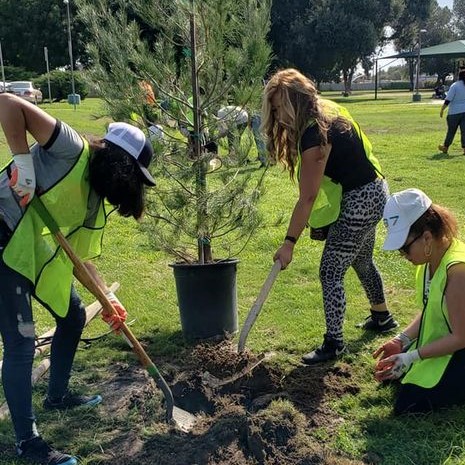5 Ways Our Grassroots Movement Is Restoring and Protecting Land
During Shelter-In-Place, have you noticed with fresh eyes how land in your community is used and what impacts it has on your community’s health?
Our communities’ mental and physical health are strongly tied to the way the land around us is used and developed, whether it hosts parks and bike lanes or oil drilling and trash incinerators. And the way we use the land can determine the safety of our air and water, the accessibility of affordable produce, and the health of our local ecosystem of plants and animals. During the pandemic, more light has been brought to the reality that not all communities in this country have been developed to protect their health due to inequitable land use practices rooted in systemic racism. Find out more from Prevention Institute here.
The good news is that these land use decisions can be changed for the better. Many of our grantees are leading their communities in developing land use practices that prioritize the health and wellbeing of their communities and local environment. Here are five ways:
Community Gardens

Many of our grassroots grantees have formed community gardens to bring affordable, fresh, healthy food to their neighborhoods. This work creates a powerful side effect — starting community conversations around our relationship with our food, land, and local ecosystem. Our Puget Sound Stewardship & Mitigation Fund grantee Black Farmers Collective in Seattle formed as a mutual aid network of Black-led, regenerative farms. The coop provides food and experiential education to youth and community members. Plus, the gardens’ various green infrastructure installations reduce stormwater overflow into Puget Sound, prevent flooding on the farm, and reuse 54,000 gallons of water per year for irrigation.
Community Infrastructure

Another way our grantees are changing residents’ relationships with the land around them is by building accessible public infrastructure. In the Central Valley, our California Environmental Grassroots Fund grantee Greenfield Walking Group (GWG) is engaging its community in local planning to build the infrastructure improvements that residents need, including sidewalks, park improvements, and even sewage systems. As an unincorporated community, Greenfield residents have to fight for basic forms of public infrastructure at the county level. That’s why GWG is getting residents of all ages involved and engaged in County planning. The group started with gathering residents’ visions for Greenfield. With their ideas in mind, GWG is advocating for public infrastructure to be included in the updated Kern County Plan, from sidewalks and gutters; to safe routes for students to walk or bike to school; park improvements for public safety such as better lighting at night; and a sewer system installation. The group is also advocating to fund alternative transportation options in the County’s Plan. With the community’s engagement in these processes, GWG is leading their county in developing truly inclusive and responsive land use planning.

Conservation Certification
Commercial agriculture has historically degraded ecosystems, polluted watersheds, and decreased biodiversity. And as cannabis farming moves into the mainstream as one of California’s primary cash crops, it is no exception. Our California Wildlands Grassroots Fund (Cal Wildlands) grantee Cannabis for Conservation has an innovative solution: with support from a Rose Foundation grant, the group is working with California’s Department of Fish and Wildlife to develop an entirely new and unique wildlife conservation certification program that will increase habitat connectivity and encourage wildlife-friendly land management practices on cannabis farms in Humboldt County.
Ending Extraction
One of the biggest disruptions to our ecosystems comes from extractive industries — think drilling for fossil fuels and mining for precious metals. In Grass Valley, CA, our Cal Wildlands grantee Community Environmental Advocates Foundation (CEAF) is standing up to stop a gold mine from reopening and destroying the local environment and critical wildlife habitats. The good news — CEAF has stopped this mine from reopening before, thanks to a lengthy Environmental Impact Review (EIR) process, and it plans to succeed once again! The group is launching a full-fledged community opposition campaign with their all-volunteer team. The team is deeply researching the environmental impacts of the mine and providing critical public comment during the EIR process. They are also launching a robust public outreach and education campaign to spread the word about the negative consequences of the mine’s reopening. By engaging their community in the EIR process and bringing forward their own research, CEAF is demanding responsible land use that protects people and planet over corporate profit.
Forest Management
In 2020, the entire West Coast choked on smoke and saw millions of acres burned by wildfires. These fires ripped through forests and communities and forced us to breathe toxic air for weeks. The uncontrolled fires also released carbon, that had been safely sequestered in trees, into our atmosphere where it speeds global warming. Drought has made our forests more vulnerable to fire, but there are also great ways to use controlled fire as a tool to improve forest health and prevent major wildfires. Our grantee Defenders of Wildlife is utilizing funding from our California Wildlands Rapid Response Fund to research and provide scientifically-sound recommendations for improved forest management to other conservation organizations throughout California. These recommendations will reintroduce the beneficial use of prescribed fire and restore natural forest structures and habitat. Thanks to this work, rebuilding resilient forests will bring so many benefits to wildlife, water quality, climate resilience, and communities’ safety!
The land around us is our link, connecting us to our ecosystems. Thanks to tireless efforts at the grassroots, our communities are changing the way we use that land, so it benefits our health and wellbeing and supports wildlife habitat.

